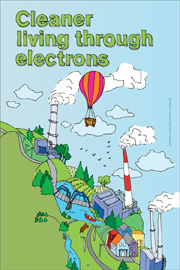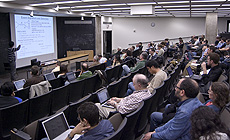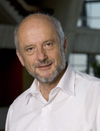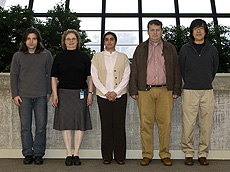|
Have a safe day!
Tuesday, Nov. 3
3:30 p.m.
DIRECTOR'S COFFEE BREAK - 2nd Flr X-Over
4 p.m.
Accelerator Physics and Technology Seminar - One West
Speaker: Bill Ng, Fermilab
Title: Coupling Impedances of Accelerator Rings (Part 1 of 3)
Wednesday, Nov. 4
3:30 p.m.
DIRECTOR'S COFFEE BREAK - 2nd Flr X-Over
THERE WILL BE NO FERMILAB COLLOQUIUM THIS WEEK
Click here for NALCAL,
a weekly calendar with links to additional information. |
|
|
For information about H1N1, visit Fermilab's flu information site.
|
|
Tuesday, Nov. 4
- Bagel sandwich
- Chicken and rice soup
- Italian sausage with peppers and onions
- Beef stroganoff
- Chicken lemon
- Peppered beef
- Assorted slices of pizza
- Chicken tostadas
Wilson Hall Cafe Menu
|
|
Wednesday, Nov. 4
Lunch
- Pork braciole
- Latin fried rice
- Pineapple flan
Thursday, Nov. 5
Dinner
- Red pepper soufflé with julienne of zucchini
- Lobster tail with drawn butter
- Spaghetti squash with scallions
- Steamed green beans with dill
- Crème brûlée
Chez Leon Menu
Call x3524 to make your reservation.
|
|
|
Cleaner living through electrons
 |
| An illustration reprinted from the most recent issue of symmetry magazine, now available online. |
Editor's note: The most recent issue of symmetry magazine is now available online. Reprinted below is a feature story about how industries can use particle accelerators to clean up dirty water, sewage sludge and polluted gases.
In 1988, two chemists and an environmental engineer turned an abandoned wastewater sludge treatment plant in Miami, Florida into a pilot plant to test a novel technology. They sought to determine if electron beams could remove microorganisms, toxins, and harmful chemicals commonly found in drinking water.
Funded by the US Environmental Protection Agency and National Science Foundation, Charles Kurucz and Thomas Waite of the University of Miami and William Cooper of Florida International University learned how to operate the electron accelerator, conducted experiments and showed, in one of the first large-scale demonstrations of its kind, that a beam of high-energy electrons can effectively and economically treat waste.
Today the pilot plant is abandoned. The accelerator and other equipment remain, but no research has taken place there for more than a dozen years, and not a single facility in the United States treats wastewater or sewage sludge with accelerated electrons.
Cooper, now an environmental chemist and director of the Urban Water Research Center at the University of California, Irvine, believes this can change. A renewed interest in climate change combined with new developments in accelerator technology, he says, make electron beams an optimal treatment method. "The process is not dead yet," Cooper says. "Now is the time to revisit it."
Read more
— Elizabeth Clements
|
CDF collaborators discuss recent work, goals at meeting
 |
| Fermilab scientists and visiting collaborators met Oct. 23 in One West for CDF's two-day collaboration meeting, which takes place three times a year. |
CDF collaborators met Oct. 22 and 23 at Fermilab to discuss group results and plan for upcoming winter conferences.
Representatives from each CDF physics group presented at the meeting. This included CDF's Massimo Casarsa, who discussed maintenance work during the shutdown period.
"A tremendous amount of work has been accomplished in three months in an effective and safe way," Massimo said. "Globally the detector is working very well."
Casarsa said maintenance crews performed preventive maintenance, worked on the high-voltage system of the detector's drift chamber, sealed cooling system leaks and refurbished power supplies in the silicon detector.
Crews also performed maintenance work on the CDF forward calorimeters and tied in a new emergency diesel generator, among other work.
Other topics included presentations from CDF's B-physics Group, TOP Group, QCD Group, EWK Group, Exotics Group and the Higgs Group. Collaborators meet three times a year.
— Chris Knight |
Dark matter "wrecking ball" may have hit Milky Way
From USA TODAY, Oct. 30, 2009
Darth Vader's Death Star? Ming the Merciless and his war rockets? The awesome power of Chuck Norris?
Piffle, suggests one astrophysicist, at least when it comes to explaining what force could have permanently bent a ring in our Milky Way Galaxy within the last 60 million years. The real explanation may be the power of an invisible wrecking ball made of dark matter - a cloud of the enigmatic physics particles born in the fiery aftermath of the Big Bang and weighing as much as 10 million suns.
Read more |
|
|
Accelerators for America's Future
 |
Pier Oddone |
Last week some 400 attendees participated in the Symposium on Accelerators for America's Future in Washington, D.C. They represented scientists, engineers and policy makers involved in the development and uses of accelerators: scientific research, medicine, new concepts for energy and the environment, industrial processes, security applications and education. The one-day symposium was followed by a two-day workshop to explore in detail the challenges posed by the needs of future accelerators. The meeting was remarkable for covering the wide scope of accelerator applications.
The Office of High Energy Physics within the DOE Office of Science, the predominant supporter of accelerator science and development, sponsored the meeting. The purpose of the symposium was to identify the next steps necessary to improve accelerators for each of their applications, the major cost reductions that may be possible, the areas of cross-cutting technology R&D that hold the most promise and to understand how to bridge the "valley of death" between basic research and the deployment of accelerator applications with broad impact on society.
Historically, OHEP has played a predominant role in the development of accelerators. As particle physics tackled ever more challenging and difficult questions it pushed the technological frontiers in accelerator science and design. The drive to higher energies, higher intensities and more compact beams of electrons, protons and nuclei has been at the root of most developments. More than 10,000 medical accelerators and 18,000 industrial accelerators were built over the last few decades. Light sources and neutron sources, now broadly used in scientific research in biology, material science and chemistry, find their origin in accelerators used for particle physics.
The role of OHEP in support of accelerator science in the past was generally motivated by potential applications to particle physics. The results of Accelerators for America's Future may well lead to the extension of that role: to cover explicitly areas beyond those motivated just by particle physics. This extension of advanced accelerator R&D into a broader domain would connect particle physics more broadly to societal impacts. Fermilab could make important contributions to such a program. In the meantime, we have brought to Fermilab the dozens of posters displayed at the symposium and will place them in the Wilson Hall atrium for the next couple of weeks, beginning Monday. I encourage you to explore the amazing results and ideas that they represent.
|
New employees - Oct. 26
 |
| From left: Gabriel Ghinita, CD; Elaine Sivak, WDRS; Priya Viswanathan, WDRS; Oleg Starshinov, CD; and Shuichi Kunori, PPD. |
|
|
Oct. 30 to Nov. 2
- Five stores provided approximately 48.25 hours of luminosity
- MI-52 affected by humidity
- TeV crystal collimator studies
- H- Source out drop corrected
- Store 7307 aborted
- TeV quench during shot setup
- Pelletron failure required access and repairs
- MI vacuum front end problem discovered
* The integrated luminosity for the period from Oct. 26 to Nov. 2 was 45.48 inverse pico barns.
Read the Current Accelerator Update
Read the Early Bird Report
View the Tevatron Luminosity Charts |
|